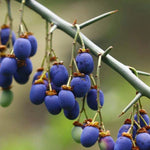Subscribe and save 10%!

Himalayan Cherry Prinsepia (Prinsepia utilis)
50 SEK
Unit price perExpected delivery date: 20 December to 27 December.
Applies to orders within Sweden. For other countries - see our delivery terms .
Out of stock
Meddela mig när produkten finns i lager:
Share
SEEDS (6pcs/bag)
Common names: Himalayan Cherry Prinsepia, Chinese Prinsepia, Himalayan Wild Cherry
Scientific name: Prinsepia utilis
Family: Rosaceae
Plant history & use:
The Himalayan Cherry Principesia is a hardy shrub with edible berries, which are very popular and often eaten as a snack by the inhabitants of its native areas. The shrub is often valued for its ability to cope with conditions of lower temperatures.
Origin is traced to the Himalayas and Manchuria.
The fruits are also often used to make juice, jams, marmalades and other preserves.
The seeds are used to produce an oil that is used in cooking (Fern, K.).
Oil extracted from the seeds is also applied to muscle pain caused by overexertion (Chopra. RN et al.). The oil is also applied to the forehead and temples to treat and relieve colds (Manandhar. NP). The fruit is used in Chinese medicine.
The seed contains about 21% fatty acids (Chopra. RN et al.). In addition to being edible, it can also be used for lighting.
The oil cake (what is left after pressing the oil from the seeds) is used for washing clothes (Manandhar. NP).
A deep purple color from the fruits is also used to paint windows and walls.
The Himalayan Cherry Principesia is grown as a hedge in the Himalayas. The shrub has an extensive root system and is used in erosion prevention to bind the soil.
The Himalayan Cherry Principesia is also valued for its ability to attract pollinators.
Culture:
A thorny shrub that often stays under 2 meters in height - however, it can grow up to 5 m. At 5-10 years of age, the shrub is considered to have reached its maximum height.
Does best in slightly moist, but well-drained soil. Preferably place in a sunny, open spot with plenty of room for the shrub to spread out. The shrub can grow to about 2.5 metres wide when fully grown.
Blooms late winter and early spring. Autumn flowers may produce ripe fruit the following spring.
The Himalayan Cherry Principesia is self-fertile and pollinated by insects.
The fruits are purple-brown to deep dark blue to black-purple, oblong, about 8mm in diameter. They ripen in autumn and often survive the entire winter intact, in their natural environment.
Sowing:
NOTE: These seeds have been stratified (cold period) and can therefore be sown immediately after receipt.
Sow the seeds in moist soil. Cover with a thin layer (about 1 cm) of soil. Keep the seeds moist. It is advisable to cover the seeds with plastic with air holes, or sow in a mini greenhouse.
Features:
Year: Perennial
Growing position: sun
Height: 1-5 m
Germination time: 2-12 weeks
USDA zone : 6-9
Growing zone (rough translation): 1-5
- Choosing a selection results in a full page refresh.
- Opens in a new window.















